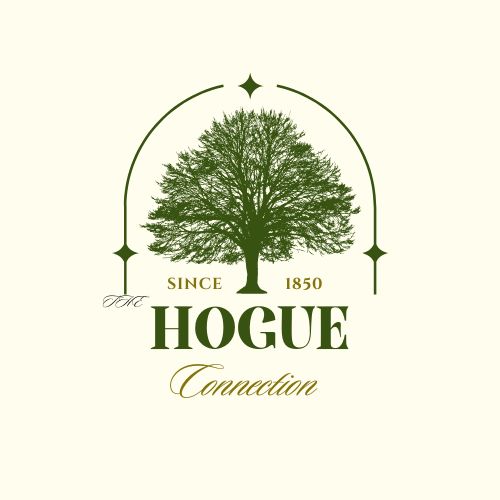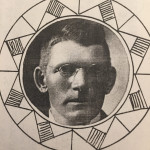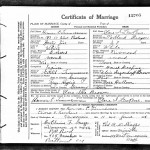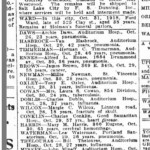Hello all, and welcome back to the Hogue Connection! The worldwide 1918 Flu Pandemic was a catastrophic event that affected many families in nearly every region of the planet. Perhaps, and not surprisingly, our family did not come out of it unscathed. In today’s post, I’d like to provide a brief look at that tragic time in history and how it revealed some interesting family lore in the process.
The “Spanish Flu” Turns Deadly
Thought to have originated in Spain, this particular virus, started out quite mildly in the spring of 1918, with only a few reported cases and even fewer deaths. People complained of chills, fever and fatigue, but most recovered in three or four days. The second wave in the fall, however, was highly contagious and wrecked havoc throughout the globe. 500 million people worldwide came down with influenza between September of 1918 and the summer of 1919, almost one third of Earth’s entire population. It was impossible to accurately count the victims. Somewhere between 50 and 100 million victims died, with over 675,000 killed in the United States alone.
Many of the victims were younger and stronger than you might expect. Most flu strains prey and either the very elderly or infants. This one attacked people in the prime of their lives. The average life expectancy of a person here in the U.S. was 51 years in 1917; it fell to 39 years by the end of 1918. The flu hit many soldiers fighting in World War I the hardest. More United States servicemen were killed by the 1918 Flu Pandemic than were killed in battle during the war. This pandemic wiped out entire families, leaving orphans, widows, and widowers by the thousands. Hospitals and funeral homes couldn’t handle the amount of bodies coming their way.
Why was this particular strain of the flu so deadly? Mainly because of the unsanitary conditions all over the world, but particularly, of the environment around soldiers fighting in the war. The flu spread quickly through the close quarters of the military training facilities, and eventually followed the fight into the muddy, disease-ridden trenches that were the battlefield of the first world war. The first flu vaccines were finally developed in the 1940’s. Also, general sanitation practices have greatly improved. If you’d like to read more about the 1918 Flu Pandemic, I’ve listed some sources at the end of this article.
The Story of Herman Timmerman Starts Here…
It took a little digging, but I found one example in our family tree on how the 1918 Flu Pandemic was a factor in the life of an ancestor. It is quite possible that we have other victims of the 1918 flu in our tree, but I haven’t tracked down anything specific yet. Let’s look at the life my wife Jane’s great uncle, Herman C. Timmerman.
Herman was born in September 1872 in Cottage Grove, Wisconsin. He was an older brother of Jane’s grandfather, Julius Timmerman, the seventh of nine children all told. The family moved to Sheldon, Iowa in 1882, then on to El Reno, Oklahoma in 1898. Herman married his first wife, Jessie Cole, in El Reno, on 7 Mar 1899. The newlyweds left Oklahoma soon after and moved to Minneapolis, MN, recorded here in the 1900 census. A city directory confirmed his employment as an engineer at Smith and Wyman Co., a sash and door manufacturer.
Herman and Jessie lived in Minneapolis for several years. Their daughter, Grace was born in 1908. In 1910, they relocated briefly to Charles City, Iowa, and lived there with Jessie’s father, Perrin Cole, where they were recorded on the 1910 census. We know from a city directory that they were back in Minneapolis by 1914, and likely remained in the area until about 1917, when Herman decided to make a big change and head to the Pacific Northwest.
A Word or Two About the Brown Sisters…
Family records are sparse on this part of the family, but I’ll reconstruct things as well as I can. Jane’s great-grandfather, U.S. Brown, a civil war veteran, started his career as a reporter and editor of many newspapers in the Midwest. He moved his family (daughters Leona, Jennie, and Clara, and son, Lamar) from Ida Grove, IA to El Reno, OK in 1902. His wife, Rose, had passed away in 1891. Remember that Herman left El Reno for Minneapolis in 1899. Herman’s younger brother Julius married Leona Brown on 11 Aug 1903.
Leona was a seamstress for a time in Sioux City, IA and probably was a big influence in the decision for Jennie and Clara to open up their own millinery shop in nearby Piedmont in 1904. Leona and Julius started their family in Piedmont, then moved back to Sheldon, IA in 1911. After a short lived marriage to a man named Hanson, Clara married Jacob Lenkens (she was 18, he was 40) and moved north to Newkirk, Kay County, OK in 1908, as recorded on the 1910 census.
My hypothesis…Herman came back to El Reno for his brother’s wedding in 1903 and met Clara Ida Brown at that time. She would have been 13 years old. Let’s get back to Herman’s story.
Herman Moves to Portland, Oregon…
We don’t know what events precipitated Herman’s move to Portland. The PNW was a huge forestry region then, and still is today. I think he probably decided to find work in the sash and door industry in Portland. We know he made this decision sometime between 1914 and 11 Jun 1918. Unfortunately there is no documentation of anything that may have influenced him. Until another cousin surfaces with more information, it’s left up to pure speculation. He divorced Jessie sometime in this period, probably 1917, and left her and Grace in Minneapolis, heading to Oregon.
So, on 11 Jun 1918, Herman C. Timmerman, age 45, of Portland, OR, married Clara I. Lenkens, age 27, also of Portland, in Vancouver, Washington. Bride and groom both declared on the license that they were divorced and on their second marriage. Their parents listed on the license match family history. Did the pair keep in touch for 15 years some how? What led to them getting together? There are many questions that will likely go unanswered. Why Vancouver, WA? Construction on the Interstate Bridge, a two lane span of road 3500 feet long was open to public use on 14 Feb 1917, connecting the cities of Portland and Vancouver for the first time. The newlyweds might have arranged for a car, paid the 5 cent toll (each way), and made an adventure of their wedding day.
The 1918 Flu Pandemic Takes Another Victim…
Wedded bliss was over much too soon. As we know now, the 1918 flu was a brutal virus. Most victims died within hours or days of developing symptoms, their skin turning blue and their lungs filling up with fluid, causing them to suffocate. On October 28, 1918, Herman C. Timmerman died at Auditorium Hospital in Portland, Oregon, aged 46. Cause of death was listed in the newspaper as pneumonia. He was buried in the Multnomah Park Cemetery, 82nd Avenue and SE Holgate Ave, Portland. Herman and Clara’s marriage lasted only 138 days.
Jane and I went to the cemetery and tracked down Herman’s grave, using Find-A-Grave and a map provided online. It took us about and hour to find it as grass had covered most of his marker. The marker, made of sandstone, weathered over the years almost to the point of being unreadable. He was likely buried by the city of Portland at the lowest cost possible. We are pretty sure we are the only people to have visited the grave in about 100 years, perhaps since Clara visited it before heading to California.
A Postscript…
About all we know about the rest of Clara’s life we have learned from the obituaries recorded in family records. She moved to San Gabriel, CA in 1935 and soon married George Burkhart, who, like her father, was also a newspaper editor. She died there 6 May 1955.
Herman’s first wife, Jessie, never remarried and died in Charles City, IA on 24 May 1932. Their daughter, Grace, married Darrell Coacher in 1932, had one daughter, and died in Minneapolis 13 Mar 1988. We are not in contact with anyone from this branch of the family at this time.
Well, that’s about all I have for today. On a side note, a cousin of ours, Lavonna Wood, sent me a link to another story relating to the New London School explosion I wrote about on my last post. She also had a relative in that explosion, a survivor, and the story is about him. You can check it out here. Thanks for reading my blog post, everybody!
Sources
https://weather.com/health/cold-flu/news/2018-12-14-deadliest-flu-pandemic-in-history#23
https://www.history.com/topics/world-war-i/1918-flu-pandemic
https://en.wikipedia.org/wiki/Spanish_flu
http://time.com/79209/solving-the-mystery-flu-that-killed-50-million-people/
September 1918: War, Plague and the World Series by Skip Desjardin, published August 27th 2018, Regnery History, ISBN 1621576205 (ISBN13: 9781621576204)
Very, Very, Very Dreadful: The Influenza Pandemic of 1918 by Albert Marrin, published January 9th 2018, Knopf Books, ISBN 1101931469 (ISBN13: 9781101931462)





[…] If you recall, a year ago I wrote a post about the Spanish Flu Pandemic of 1918. You can read that here. It will remind you that things were crazy for our ancestors, too. Thanks for reading my blog. To […]
[…] I touched on one of those mysteries in a previous article that you can read again by following this link. […]